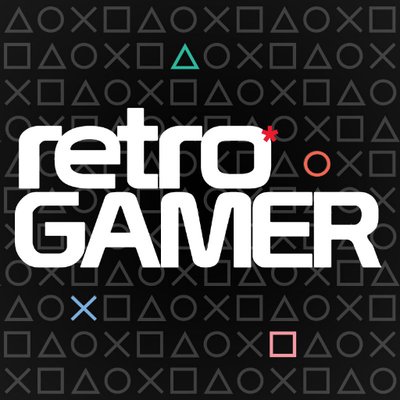"We were basically trying to keep Harmonix afloat": The making of Guitar Hero
The story of how Harmonix converted iconic rock songs into an accessible gaming experience

Imagine for a second that you're part of one of the biggest rock bands on the planet and you receive a call from a little-known game developer asking to put your iconic song into a video game played with a plastic toy guitar. Would you take that risk? This was the question posed by Harmonix in its pursuit of making the ultimate rock videogame: Guitar Hero.
Released in November 2005 for the PS2 by Harmonix and RedOctane, it spawned a series of over 20 titles and expansions across multiple platforms in just five years. The concept behind the game was simple yet hard to describe, so persuading bands to license their music was a tricky task.
"We really wanted it to be a tour through all the genres of rock... to be true to the entire spectrum of rock music," says Greg LoPiccolo, project director for the game. The game's 30 main tracks were pared down from an initial list of 300, yet it still managed to include some of the most recognisable rock tracks in history.
There was at least precedence for this type of game, with the Japanese arcade game Guitar Freaks in which players strum along on a plastic guitar to rock and J-pop tunes. RedOctane contacted Harmonix, which had seen success with its previous music games, to create a westernised equivalent. Harmonix agreed, but only if it could focus solely on rock music.
"A bunch of us at the studio were rock musicians and really into rock and roll culture," says Greg. "So we thought that we could do it justice. We can crush this assignment, it's about rock-and-roll!"
The sound of music

What's perhaps most remarkable about Guitar Hero's development is that it was created in under a year. With such a short lead time and a modest budget, Greg and his team had tight constraints. Yet with such a focused concept, the game stuck almost exactly to the original specification. "We knew what we wanted to do, RedOctane was an awesome partner, we had all the right people in the right roles," remembers Greg. "It went very smoothly."
What certainly helped was the studio's previous releases: Frequency and Amplitude. Both involve beat-matching along a moving pathway, setting the foundation for Guitar Hero. Key lessons were learned, such as how fast to move the 'gems', how big they needed to be, and what the UI would look like. There was more to the tracklist than just contacting big names, however.
Weekly digests, tales from the communities you love, and more
"We knew that we wanted big, iconic guitar-driven songs that had variety in style and feel but all fit solidly into Guitar Hero's focused rock aesthetic," says Eric Brosius, audio lead on the game. "What we didn't know was what made a great song a great Guitar Hero song and what was the range of difficulty we could expect players to handle."
The process began with a handful of test songs, with Eric and team recording their own versions of songs to play around with. This was a vital first step. "These were a lot of fun to make but more importantly very useful to us in learning about what kind of guitar parts worked well, what was too easy or too hard," says Eric. "And also they helped give the team a more tangible idea of what the game might feel like to play."
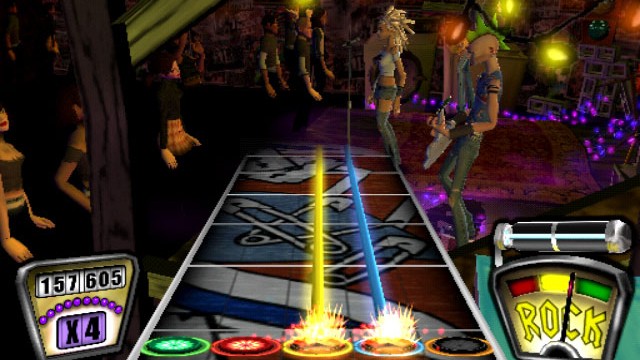

If you want in-depth features on classic video games delivered straight to your doorstop, subscribe to Retro Gamer today.
That gave Eric confidence in his work. "I remember playing through and getting that feeling of excitement and being in the zone playing a song, forgetting that I'm playing a videogame," he says. "Then it clicked for me and I thought, 'Wow, if other people can feel this way too, this will be a big deal.'"
From there, the initial list of songs was prioritised using various metrics like genre and style, difficulty and how iconic a song is. This formed the basis for the licensing agent tasked with formally acquiring the necessary rights. There was an extra hiccup, though. For the game to work, the audio team required the guitar tracks to be separate from the other instruments so the sound could drop in and out as the player strums. Record labels don't provide music in this way, so Harmonix enlisted the aid of production company WaveGroup to re-record the songs from scratch in the necessary format.
"WaveGroup really did a fantastic job in nailing the production, the guitar tone and playing, and even the singers' voices," says Eric. "It was a big task and they did it really well." A byproduct of the game's success was music discovery, something that the team expected somewhat.
"[We did] our best to put something together that really introduces people to a spectrum of things," says Greg. "It worked much better than we thought it would. Some of those bands had a rebirth a little bit, based on their inclusion in one of the Guitar Hero or Rock Band games after that."
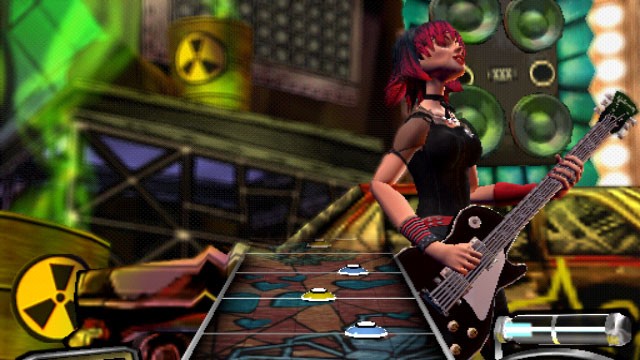
What's more, the audio team was able to include bonus tracks from smaller local bands, offering exposure on a potentially huge platform. The original tracks were also simpler to acquire. "Because we personally knew these bands, it was easy to get them on board without burdening our licensing agent who was plenty busy trying to secure the main songs for the soundtrack," says Eric. "It then sort of became a tradition at Harmonix to include bonus songs like this in many of our games."
Between Harmonix and RedOctane, the guitar peripheral went through multiple iterations, with guitar size, price, and the ability to play lefty or righty all key considerations. Most important was the left hand button positioning: their height, their travel, and click-feel. Imported Guitar Freaks guitars were used as a test, but a more authentic shape and a commitment to five buttons were eventually chosen to allow for a shift in the left hand.
The Harmonix team also lobbied heavily for the whammy bar to bend pitch – an expensive addition that certainly added to the fun of playing the game. An even more iterative process, though, was designing the left-hand patterns to ensure a balance of difficulty and authenticity. Eric and the team created informal guidelines, such as which button combinations feel most like power chords, and how to break up long melodic phrases with more notes than buttons.
"I remember learning how to play a lot of these songs on my real guitar to help compare the feeling of playing it for real to playing it within the game," remembers Eric. Having so many guitarists on the team provided expertise to get the right feel, and the result was a happy medium between simple beat matching and authenticity. Those guidelines additionally helped establish the two axes of difficulty: the order the songs were presented and the four difficulty levels for each.
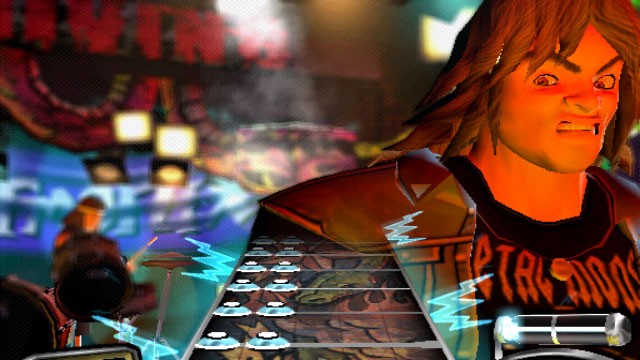
"We tried hard to make sure that the difficulty always increased evenly and at the right pace," says Eric. "We didn't want people getting stuck or frustrated because it suddenly became too hard, nor did we want people to feel like they weren't progressing." The best way to do this was to work backwards.
"One of the things we figured out was to start with Expert and try to get it to match the contours of the music in as much detail as we could and then simplify for each successive drop down," says Greg.
Along with the tracklist's rock history vibe, the visuals encompass various rock styles. From the player characters, to the menus and the loading screens, rock cliches were very much leaned into. This was proposed by art director Ryan Lesser, with the cartoon aesthetic a result of platform limitations.
"Doing photorealism on a PS2 with all the other stuff we were doing was out of the question," says Greg. "And so he brought to us this sense of, 'Let's have giant stacks of amps but they're asymmetrical and toppling over...' and we let him roll with that and it came out great!"
So what were the team's expectations for Guitar Hero? "We hoped it would do okay!" says Greg. "At that point, our goal was to develop games that were successful enough to justify sequels. We were basically making payroll, trying to keep the company afloat. I think we had this overarching belief that music gaming could be a big category. If we could find the right formula, it would be very entertaining and people would like it."

They certainly did. The game's success not only generated millions of dollars, but snowballed into a whole movement of music video games that transformed Harmonix from a small developer to a major player. Though the Sony-published Singstar released the year before, the Guitar Hero brand inspired multiple successors: DJ Hero, Rock Band, Rocksmith and many more.
That is, until the genre reached saturation point and plummeted in popularity. The genre's drop-off came as a surprise to Greg, who envisioned indies picking up where Harmonix left off. Yet a lack of player creativity stunted growth.
As Greg notes, "There was a limit as to how much time people were willing to spend getting really good at pretending to play other people's music... But it never really turned into a viable genre and I think that's because there was a design bottleneck.
"That's the problem with music, as a musician it's hard to get good enough to have [a rock star] experience on a conventional instrument," Greg continues. "You have to put years of effort into it and for a lot of people that's not possible for them. A lot of people don't get there. And that was the cool thing about Guitar Hero, you could get there in a weekend."
Rolling with the punches
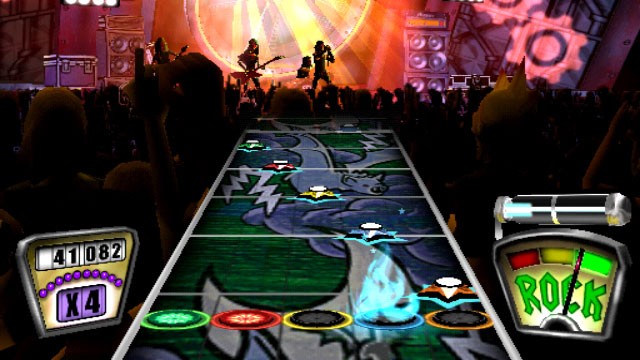
"We didn't want people getting stuck or frustrated because it suddenly became too hard"
Eric Brosius
Eric also acknowledges the limits of the genre: "Guitar Hero and Rock Band are very skill-based games that come with a great vibe and atmosphere, but are at heart very score-oriented." That's why Harmonix has moved towards exploring creative expression, for example with its forthcoming Fuser.
"We'd like to give non-musicians that thrill of creating music, not just performing music, in a game format," says Eric. "It's a challenge, but one we're excited to work on." Even though the future of music games is moving in a more creative direction, the legacy of Guitar Hero is far more than plastic instruments in your attic. What struck a chord with Greg was the illusion of making music.
"Even people who don't have musical skills have a desire to have a musical experience that's immersive and good enough to have them feel engaged with the music," he says. "That's the thing we did well that made it successful, was it gave you the illusion that you were playing, you really felt like you were generating music."
With its iconic tracklist, innovative peripheral and tongue-in-cheek aesthetic, Guitar Hero truly offered the fantasy of being a rockstar.
This feature first appeared in Retro Gamer magazine issue 212. For more excellent features, like the one you've just read, don't forget to subscribe to the print or digital edition at Magazines Direct.
Retro Gamer is the world's biggest - and longest-running - magazine dedicated to classic games, from ZX Spectrum, to NES and PlayStation. Relaunched in 2005, Retro Gamer has become respected within the industry as the authoritative word on classic gaming, thanks to its passionate and knowledgeable writers, with in-depth interviews of numerous acclaimed veterans, including Shigeru Miyamoto, Yu Suzuki, Peter Molyneux and Trip Hawkins.
